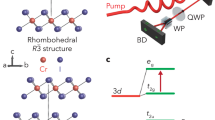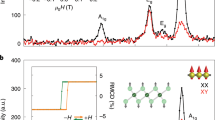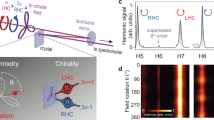Abstract
In a solid, the electronic subsystem can exhibit incipient order with lower point group symmetry than the crystal lattice. Ultrafast external fields that couple exclusively to electronic order parameters have rarely been investigated, however, despite their potential importance in inducing exotic effects. Here we show that when inversion symmetry is broken by the antiferromagnetic order in Cr2O3, transmitting a linearly polarized light pulse through the crystal gives rise to an in-plane rotational symmetry-breaking (from C3 to C1) via optical rectification. Using interferometric time-resolved second harmonic generation, we show that the ultrafast timescale of the symmetry reduction is indicative of a purely electronic response; the underlying spin and crystal structures remain unaffected. The symmetry-broken state exhibits a dipole moment, and its polar axis can be controlled with the incident light. Our results establish a coherent nonlinear optical protocol by which to break electronic symmetries and produce unconventional electronic effects in solids.
This is a preview of subscription content, access via your institution
Access options
Access Nature and 54 other Nature Portfolio journals
Get Nature+, our best-value online-access subscription
$29.99 / 30 days
cancel any time
Subscribe to this journal
Receive 12 print issues and online access
$259.00 per year
only $21.58 per issue
Buy this article
- Purchase on Springer Link
- Instant access to full article PDF
Prices may be subject to local taxes which are calculated during checkout




Similar content being viewed by others
Data availability
The data that support the findings of this study are present in the paper and/or in the Supplementary Information and are deposited in the Zenodo repository at https://doi.org/10.5281/zenodo.10674665 (ref. 41). Additional data related to the paper are available from the corresponding author upon request.
References
Powell, R. Symmetry, Group Theory, and the Physical Properties of Crystals (Springer, 2010).
Kivelson, S. A., Fradkin, E. & Emery, V. Electronic liquid-crystal phases of a doped Mott insulator. Nature 393, 550–553 (1998).
Lilly, M. P. et al. Evidence for an anisotropic state of two-dimensional electrons in high Landau levels. Phys. Rev. Lett. 82, 394–397 (1999).
Feldman, B. E. et al. Observation of a nematic quantum Hall liquid on the surface of bismuth. Science 354, 316–321 (2016).
Borzi, R. et al. Formation of a nematic fluid at high fields in Sr3Ru2O7 at high magnetic fields. Science 315, 214–217 (2007).
Harter, J. et al. A parity-breaking electronic nematic phase transition in the spin-orbit coupled metal Cd2Re2O7. Science 356, 295–299 (2017).
Wu, J. et al. Spontaneous breaking of rotational symmetry in copper oxide superconductors. Nature 547, 432–435 (2017).
Chu, J. et al. Divergent nematic susceptibility in an iron arsenide superconductor. Science 337, 710–712 (2012).
Wu, J. et al. Electronic nematicity in Sr2RuO4. Proc. Natl Acad. Sci. USA 117, 10654–10659 (2020).
Ronning, F. et al. Electronic in-plane symmetry breaking at field-tuned quantum criticality in CeRhIn5. Nature 548, 313–317 (2017).
Okazaki, R. et al. Rotational symmetry breaking in the hidden-order phase of URu2Si2. Science 331, 439–442 (2011).
Sirica, N. et al. Photocurrent-driven transient symmetry breaking in the Weyl semimetal TaAs. Nat. Mater. 21, 62–66 (2022).
Sirica, N. et al. Tracking ultrafast photocurrents in the Weyl semimetal TaAs using THz emission spectroscopy. Phys. Rev. Lett. 122, 197401–197405 (2019).
Shirley, J. Solution of the Schrodinger equation with a Hamiltonian periodic in time. Phys. Rev. 138, B979–987 (1965).
Oka, T. & Kitamura, S. Floquet engineering of quantum materials. Annu. Rev. Condens. Matter Phys. 10, 387–408 (2019).
Morimoto, T. & Nagaosa, N. Topological nature of nonlinear optical effects in solids. Sci. Adv. 2, e1501524 (2016).
Kimel, A. et al. Ultrafast non-thermal control of magnetization by instantaneous photomagnetic pulses. Nature 435, 655–657 (2005).
Satoh, T. et al. Spin oscillations in antiferromagnetic NiO triggered by circularly polarized light. Phys. Rev. Lett. 105, 077402 (2010).
Tzschaschel, C. et al. Ultrafast optical excitation of coherent magnons in antiferromagnetic NiO. Phys. Rev. B 95, 174407 (2017).
Pershan, P. S., van der Ziel, J. P. & Malmstrom, L. D. Theoretical discussion of the inverse Faraday effect, Raman scattering, and related phenomena. Phys. Rev. 143, 574–583 (1966).
Shan, J. et al. Giant modulation of optical nonlinearity by Floquet engineering. Nature 600, 235–239 (2021).
Sie, E. et al. Valley-selective optical Stark effect in monolayer WS2. Nat. Mater. 14, 290–294 (2015).
Sie, E. et al. Large, valley-exclusive Bloch-Siegert shift in monolayer WS2. Science 355, 1066–1069 (2017).
Wang, Y. et al. Observation of Floquet-Bloch states on the surface of a topological insulator. Science 342, 453–457 (2013).
Mahmood, F. et al. Selective scattering between Floquet–Bloch and Volkov states in a topological insulator. Nat. Phys. 12, 306–310 (2016).
McIver, J. W. et al. Light-induced anomalous Hall effect in graphene. Nat. Phys. 16, 38–41 (2020).
Boyd, R. Nonlinear Optics (Academic Press, 2020).
Bass, M. et al. Optical rectification. Phys. Rev. Lett. 9, 446–448 (1962).
Kaplan, D., Holder, T. & Yan, B. Nonvanishing subgap photocurrent as a probe of lifetime effects. Phys. Rev. Lett. 125, 227401 (2020).
Fiebig, M., Pavlov, V. & Pisarev, R. Second-harmonic generation as a tool for studying electronic and magnetic structures of crystals: review. J. Opt. Soc. Am. B 22, 96–118 (2005).
Fiebig, M. et al. Second harmonic generation and magnetic-dipole-electric-dipole interference in antiferromagnetic Cr2O3. Phys. Rev. Lett. 73, 2127–2130 (1994).
Fiebig, M., Fröhlich, D., Sluyterman, G. & Pisarev, R. V. Domain topography of antiferromagnetic Cr2O3 by second harmonic generation. Appl. Phys. Lett. 66, 2906–2909 (1995).
Satoh, T. et al. Ultrafast spin and lattice dynamics in antiferromagnetic Cr2O3. Phys. Rev. B 75, 155406 (2007).
Satoh, T. et al. Time-resolved demagnetization in Cr2O3 by phase sensitive second harmonic generation. Phys. Rev. B 310, 1604–1606 (2007).
Sala, V. et al. Resonant optical control of the structural distortions that drive ultrafast demagnetization in Cr2O3. Phys. Rev. B 94, 014430 (2015).
Birss, R. Symmetry and Magnetism (North Holland, 1966).
Muthukumar, V., Valentí, R. & Gros, C. Microscopic model of nonreciprocal optical effects in Cr2O3. Phys. Rev. Lett. 75, 2766–2769 (1995).
Muto, M. et al. Magnetoelectric and second-harmonic spectra in antiferromagnetic Cr2O3. Phys. Rev. B 57, 9586–9607 (1998).
Muthukumar, V., Valentí, R. & Gros, C. Theory of nonreciprocal optical effects in antiferromagnets: the case of Cr2O3. Phys. Rev. B 54, 433–440 (1996).
Tanabe, Y., Fiebig, M. & Hanamura, E. in Magneto-optics (eds Sugano, S. & Kojima, N.) 107–136 (Springer, 1999).
Xinshu, Z. Light-induced electronic polarization in antiferromagnetic Cr2O3. Zenodo https://doi.org/10.5281/zenodo.10674665 (2024).
Acknowledgements
We thank M. Ye, D. Kaplan, H. Ning, C. Belvin and W. Campbell for helpful conversations related to this work. Research at the University of California Los Angeles (UCLA) was supported by the US Department of Energy, Office of Science, Office of Basic Energy Sciences under award no. DE-SC0023017 (A.K.). The work at Rutgers was supported by the W. M. Keck Foundation (S.-W.C.). A.B.C. and R.R. acknowledge financial support from the University of California Laboratory Fees Research Program funded by the University of California Office of the President (grant number LFR-20-653926). A.B.C. acknowledges financial support from the Joseph P. Rudnick Prize Postdoctoral Fellowship (UCLA).
Author information
Authors and Affiliations
Contributions
X.Z. and T.C. built the SHG set-up and performed the time-resolved SHG experiments under the supervision of A.K.; X.Z. analysed the data under the supervision of A.K.; K.D. and K.W. grew the single crystals under the supervision of S.-W.C. Theoretical calculations were carried out by A.B.C. with input from R.R., X.Z. and A.K. The paper was written by X.Z., A.B.C. and A.K. with input from all authors.
Corresponding author
Ethics declarations
Competing interests
The authors declare no competing interests.
Peer review
Peer review information
Nature Materials thanks Manfred Fiebig and the other, anonymous, reviewer(s) for their contribution to the peer review of this work.
Additional information
Publisher’s note Springer Nature remains neutral with regard to jurisdictional claims in published maps and institutional affiliations.
Supplementary information
Supplementary Information
Supplementary Figs. 1–7 and discussion.
Rights and permissions
Springer Nature or its licensor (e.g. a society or other partner) holds exclusive rights to this article under a publishing agreement with the author(s) or other rightsholder(s); author self-archiving of the accepted manuscript version of this article is solely governed by the terms of such publishing agreement and applicable law.
About this article
Cite this article
Zhang, X., Carbin, T., Culver, A.B. et al. Light-induced electronic polarization in antiferromagnetic Cr2O3. Nat. Mater. (2024). https://doi.org/10.1038/s41563-024-01852-w
Received:
Accepted:
Published:
DOI: https://doi.org/10.1038/s41563-024-01852-w



